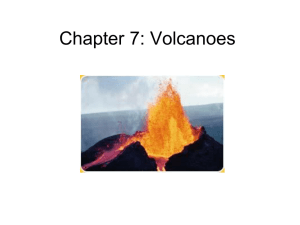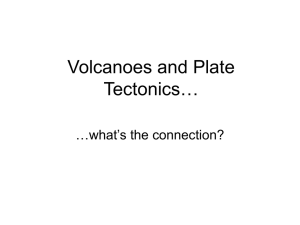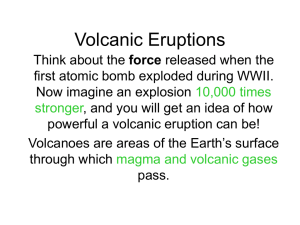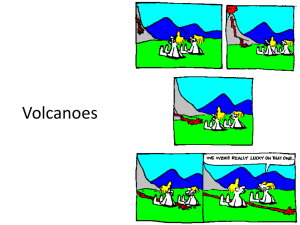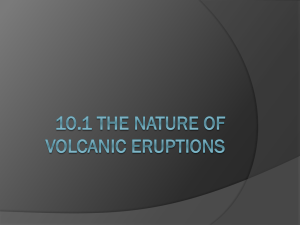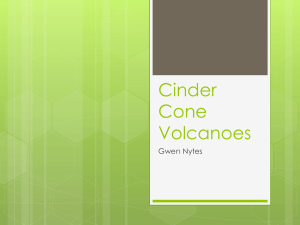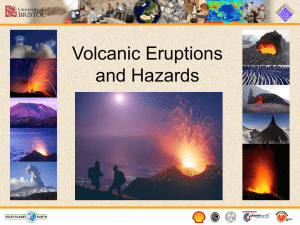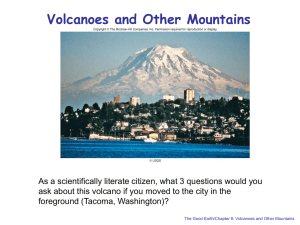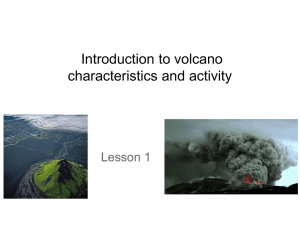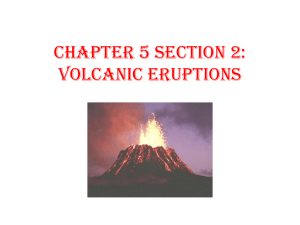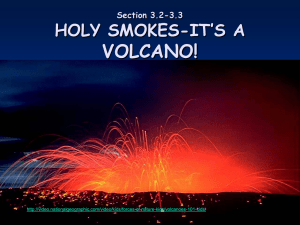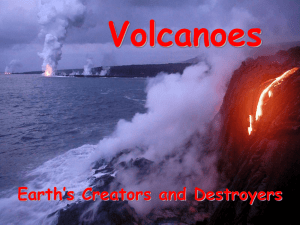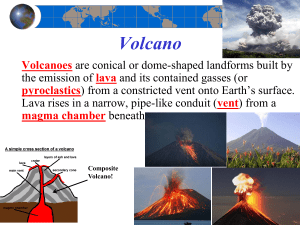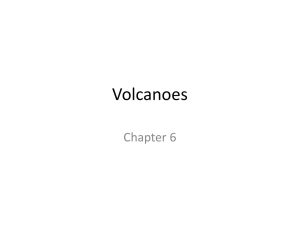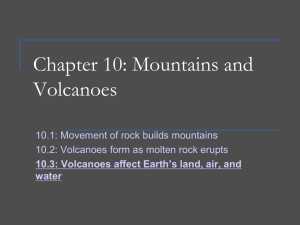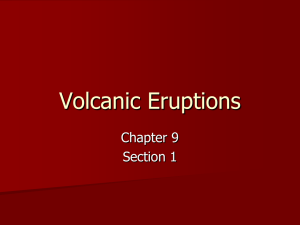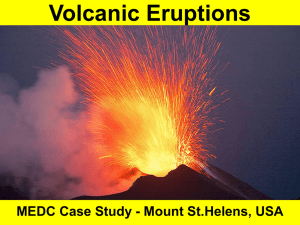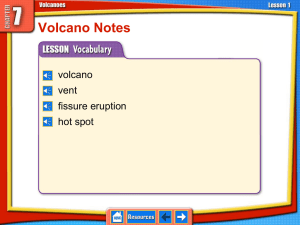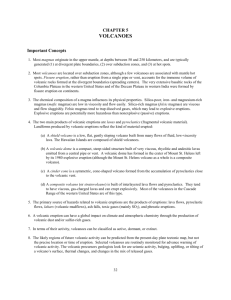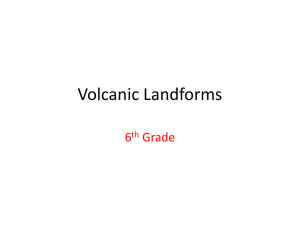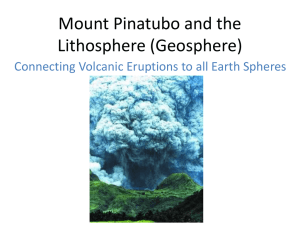3. Materials extruded during an eruption
advertisement
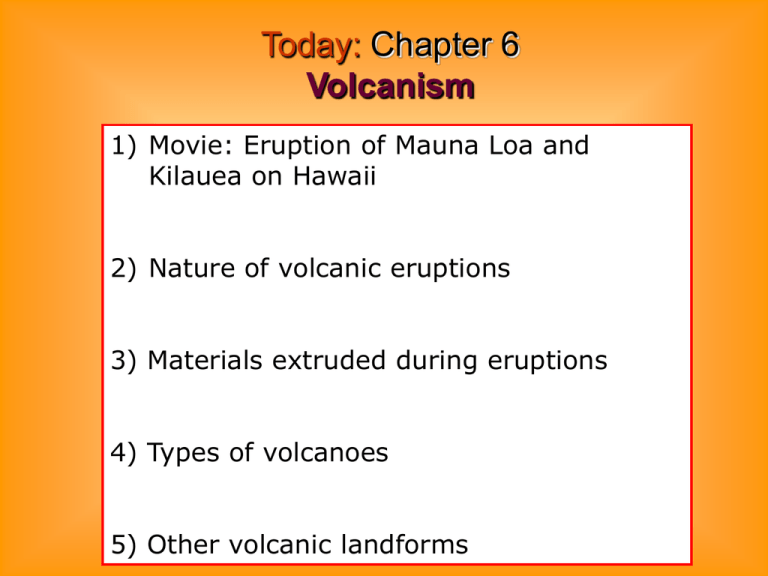
Today: Chapter 6 Volcanism 1) Movie: Eruption of Mauna Loa and Kilauea on Hawaii 2) Nature of volcanic eruptions 3) Materials extruded during eruptions 4) Types of volcanoes 5) Other volcanic landforms 2. 1. The nature of volcanic eruptions What determines if an eruption is - violent? - “gentle”? 3 primary factors: magma’s composition more silica more viscous (chains) magma’s temperature hotter magma magma viscosity less viscous amount of gas in magma Can increase fluidity Its ability to move 2. 1. The nature of volcanic eruptions Importance of gas in eruptions Gas can provide the force to violently hurl molten rock & ash from volcano 2. 1. The nature of volcanic eruptions •Fluid basaltic lavas generally produce quiet eruptions •Highly viscous lavas (rhyolite or andesite) produce more explosive eruptions 2. 1. The nature of volcanic eruptions 80% of all volcanoes are found along convergent plate boundaries. Fig. 6.18 3. 2. Materials extruded during an eruption Volcanoes erupt: lava gas pyroclastic materials broken rock ash dust 3. 2. Materials extruded during an eruption lava gas pyroclastic stuff Basaltic (low Si content) pahoehoe flow flows in thin, broad sheets, ~10-300 meters/hr, smooth twisted or ropey texture & wrinkled outer skin with molten flow beneath (Hawaiian type) 3. 2. Materials extruded during an eruption lava gas pyroclastic stuff Basaltic (low Si content) aa flow thicker & slower flows ~5-50 meters/hr, rough & jagged surface 3. 2. Materials extruded during an eruption lava gas pyroclastic stuff Magmas contain dissolved gases, held in by pressure Reduce pressure gases escape (decompression) Gaseous portion 1-6% by weight, mostly water vapor, some CO2 3. 2. Materials extruded during an eruption lava gas pyroclastic stuff Magmas contain dissolved gases, held in by pressure Phreatic explosion Hot, gas-charged magma encounters water and causes a superheated steam explosion 3. 2. Materials extruded during an eruption lava gas pyroclastic stuff Gas can blow pulverized rock, glass, ash, magma blobs into the air from a volcano Pyroclastic materials– “Fire fragments” Types of pyroclastic debris •Ash and dust - fine, glassy fragments •Volcanic bombs - ejected as blobs of lava, solidify in air 3. Materials extruded during an eruption A volcanic bomb Bomb is approximately 10 cm long lava gas pyroclastic stuff 4. Types of Volcanoes Opening at the summit of a volcano Crater - Depression at the summit < 1 km Caldera - Summit depression > 1 km, produced by collapse following a massive eruption Vent – opening connected to the magma chamber via a pipe See Fig. 6.9 4. Types of Volcanoes Key terms: magma chamber vent/pipe caldera flank eruption 4. Types of Volcanoes Types of volcanoes Shield volcano Cinder Cone Composite Cone (Stratovolcano) 4. Types of Volcanoes Broad, large area Large volumes of basaltic lava Mauna Loa on Hawaii 4. Types of Volcanoes Built from ejected lava Steep slope angle Rather small size Frequently occur in groups 4. Types of Volcanoes Sunset Crater – a cinder cone near Flagstaff, Arizona 4. Types of Volcanoes Sunset crater, AZ 4. Types of Volcanoes Composite Volcano Associated with convergent plate boundaries (e.g., Fujiyama, Mt. St. Helens) Classic-shaped volcano (1000’s of ft. high & several miles wide at base) Composed of interbedded lava flows and layers of pyroclastic debris 4. Types of Volcanoes Mt. St. Helens – a typical composite volcano 4. Types of Volcanoes Mt. St. Helens following the 1980 eruption 4. Types of Volcanoes A size comparison of the three types of volcanoes 5. Other Volcanic Landforms a. caldera crater greater than 1 km wide from collapse of summit Today, Crater Lake Also: Yellowstone! occupies a caldera 10km wide Fig. 6.10 5. Other Volcanic Landforms b. Basaltic fissure eruption Fluid basaltic lava extruded from crustal fractures called fissures Ocean ridges; Columbia River Plateau Fig. 6.13 5. Other Volcanic Landforms Columbia River Basalts Flood basalt of the Columbia River Plateau formed during extensive volcanic activity 17 mio yr ago Fig. 6.2 5. Other Volcanic Landforms c. lava dome Bulbous mass of congealed lava usually form after explosive eruption of gas-rich magma
